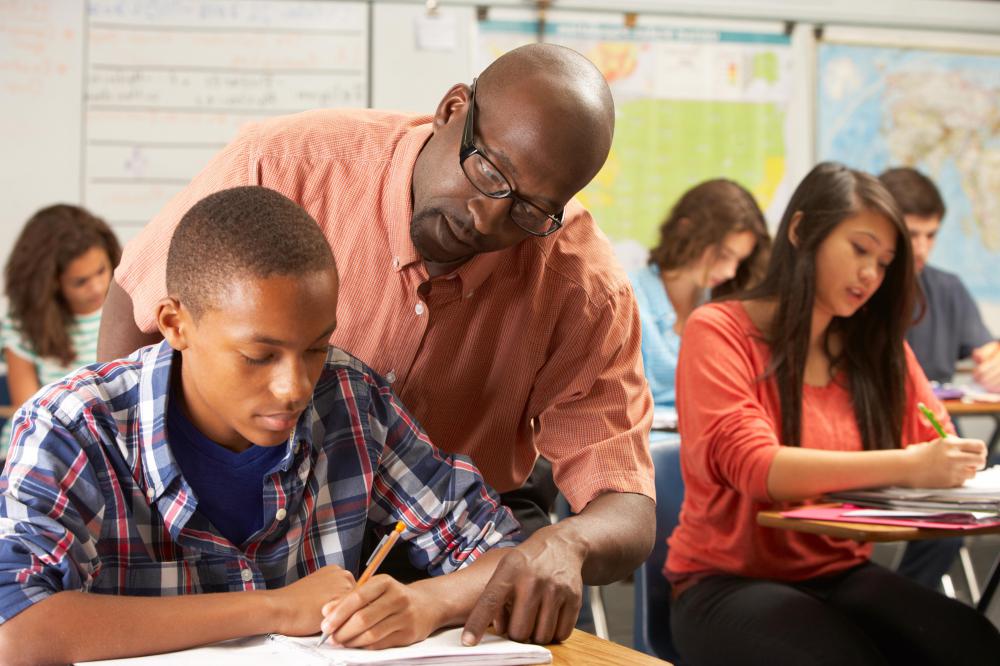At WiseGEEK, we're committed to delivering accurate, trustworthy information. Our expert-authored content is rigorously fact-checked and sourced from credible authorities. Discover how we uphold the highest standards in providing you with reliable knowledge.
What Is a Responsive Classroom?
A responsive classroom is a classroom where the instructor promotes an environment for simultaneous academic and social leaning, with a heavy stress on autonomy and confidence-building for students. This approach is effective in a variety of settings and can have a dramatic impact on learning skills and behavior problems, even in troubled school districts. It is most effective when the entire school takes on a responsive classroom approach and uses this technique to guide its policies and educational priorities. When all bases are thoroughly covered in a teaching setting, it gives way to more effective learning for the students. And despite the challenges of implementing it on a wider scale, responsive classrooms still work for the few adopters of this method.
Teachers who take this approach believe that students need to build social skills as they develop academic ones, and that a classroom where students feel safe to explore and communicate can result in better student outcomes. In a responsive classroom, the teacher considers the individual needs of students and thinks about how to balance students from different cultural, social, and academic backgrounds. This allows teachers to better gauge which students will require more focusing on and which ones will need less attention. The unity in a class like this makes it easier to cascade complex subjects that are usually heavily avoided by students. The classroom may also include a mix of students with learning disabilities and other issues that may impact their ability to learn and grow, and these must be considered as well.

The instructor in a responsive classroom asks open questions that encourage students to engage with the material and each other. Students do not memorize and repeat material, but instead build on what they learn with classroom discussions. They likely participate in group work, where they split up into smaller groups to discuss the topic of interest. Instructors encourage students to make mistakes and learn from them by providing an environment where mistakes are an opportunity for growth instead of humiliation or punishment.

In the responsive classroom, children play an active role in setting the tone. They help the teacher establish and enforce classroom rules. They also interact with each other and can take a leadership role in lessons. This will allow you to utilize the skills of the more advanced students, as they can assist their peers who are struggling with either behavioral or academic issues. The bond built through these classes are expected to sustain every individual member of the group. In whole schools, students may meet as a collective at the start of the day for a morning meeting, a check-in period where they engage in interactive activities, socialize, and talk about any academic or personal issues they may experience. This builds bonds between students and encourages cooperation on a variety of tasks. This gives them sufficient exposure to college Math and other more advanced subjects or courses. It's a great way to give them a taste of what the future holds and what they can do to ensure that they succeed in it.
Teachers can receive responsive classroom training in the process of acquiring education degrees, or through workshops after they graduate and obtain their credentials. They can help students get a high score on their SAT exams. These are just some of the many benefits of taking part in a responsive classroom. These workshops are a form of continuing education and can vary in complexity. A simple weekend workshop might provide some tips on changing behaviors in the classroom, while a longer course might allow an instructor to set up a fully responsive classroom and work with the rest of the school on promoting the use of this approach in teaching.
AS FEATURED ON:
AS FEATURED ON:












Discussion Comments
More than often, a class is more responsive when the teacher is in the classroom, as opposed to a substitute. Even though this isn't always the case, a lot of substitute teachers are taken advantage of by other students. Due to this, not much is taught during the day, and the classroom is more focused on meaningless tasks, which may include pranks and other homework.
As productive as a responsive classroom is, I think one thing people need to remember is that both the students and teachers need to make sure that they contribute to the daily activities. As an example, sometimes, it's the classroom's fault. They're just not interested in the material, and would rather do other tasks. On the other hand, it could be the teacher's fault as well. Since they're supposed to engage the class, if the material is dry, it might not interest the students too much. Overall, both sides need to make sure they're doing their equal share.
Without a responsive classroom, teaching becomes much less of an experience, and more of a chore. After all, when most teachers see that their students are wanting to participate in the discussions, it really encourages them. However, when half the class isn't paying attention and would rather use their cellphones or pick their noses, it can frustrate the instructor. Sometimes, this even leads them to wonder why they bother teaching in the first place.
Post your comments